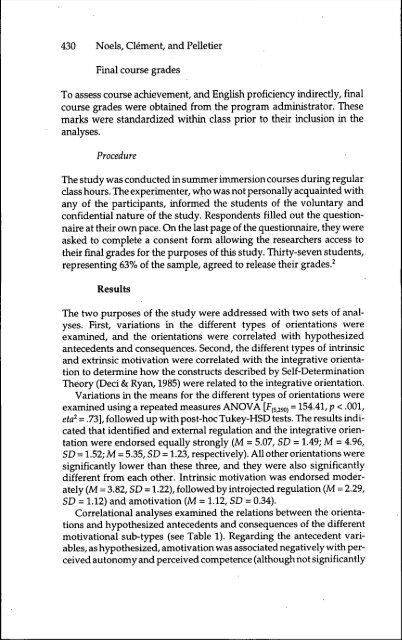Intrinsic, Extrinsic, and Integrative Orientations of French Canadian ...
Intrinsic, Extrinsic, and Integrative Orientations of French Canadian ...
Intrinsic, Extrinsic, and Integrative Orientations of French Canadian ...
You also want an ePaper? Increase the reach of your titles
YUMPU automatically turns print PDFs into web optimized ePapers that Google loves.
430 Noels, Clement, <strong>and</strong> Pelletier<br />
Final course grades<br />
To assess course achievement, <strong>and</strong> English pr<strong>of</strong>iciency indirectly, final<br />
course grades were obtained from the program administrator. These<br />
marks were st<strong>and</strong>ardized within class prior to their inclusion in the<br />
analyses.<br />
Procedure<br />
The study was conducted in summer immersion courses during regular<br />
class hours. The experimenter, who was not personally acquainted with<br />
any <strong>of</strong> the participants, informed the students <strong>of</strong> the voluntary <strong>and</strong><br />
confidential nature <strong>of</strong> the study. Respondents filled out the questionnaire<br />
at their own pace. On the last page <strong>of</strong> the questionnaire, they were<br />
asked to complete a consent form allowing the researchers access to<br />
their final grades for the purposes <strong>of</strong> this study. Thirty-seven students,<br />
representing 63% <strong>of</strong> the sample, agreed to release their grades.^<br />
Results<br />
The two purposes <strong>of</strong> the study were addressed with two sets <strong>of</strong> analyses.<br />
First, variations in the different types <strong>of</strong> orientations were<br />
examined, <strong>and</strong> the orientations were correlated with hypothesized<br />
antecedents <strong>and</strong> consequences. Second, the different types <strong>of</strong> intrinsic<br />
<strong>and</strong> extrinsic motivation were correlated with the integrative orientation<br />
to determine how the constructs described by Self-Determination<br />
Theory (Deci & Ryan, 1985) were related to the integrative orientation.<br />
Variations in the means for the different types <strong>of</strong> orientations were<br />
examined using a repeated measures ANOVA [F(5^90) = 154.41, p < .001,<br />
eta^ = .73], followed up with post-hoc Tukey-HSD tests. The results indicated<br />
that identified <strong>and</strong> extemal regulation <strong>and</strong> the integrative orientation<br />
were endorsed equally strongly (M = 5.07, SD = 1.49; M = 4.96,<br />
SD = 1.52; M = 5.35, SD = 1.23, respectively). All other orientations were<br />
significantly lower than these three, <strong>and</strong> they were also significantly<br />
different from each other. <strong>Intrinsic</strong> motivation was endorsed moderately<br />
(M = 3.82, SD = 1.22), followed by introjected regulation (M = 2.29,<br />
SD = 1.12) <strong>and</strong> amotivation (M = 1.12, SD = 0.34).<br />
Correlational analyses examined the relations between the orientations<br />
<strong>and</strong> hypothesized antecedents <strong>and</strong> consequences <strong>of</strong> the different<br />
motivational sub-types (see Table 1). Regarding the antecedent variables,<br />
as hypothesized, amotivation was associated negatively with perceived<br />
autonomy <strong>and</strong> perceived competence (although not significantly
















